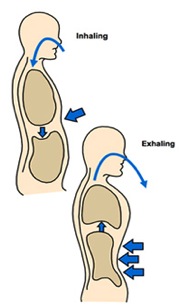Perfect abdominal breathing is readily observed in the newborn but unfortunately as we age, tension and stress in our day-to-day lives restrict this preferred pattern, resulting in a chronic and largely detrimental pattern of breathing.
And we thought breathing was one thing we couldn’t get wrong!

When we breathe, the diaphragm relaxes and contracts in order to inhale and exhale respectively (this can be easily seen by the rising and falling of the abdomen when we breathe). When an individual is under stress however, either emotional or physical, their breathing pattern changes. Typically, we take shallow breaths using our chest and shoulders, rather than our diaphragm, in order to move air in and out of our lungs, which gradually causes the body to automatically breathe into the neck and shoulders and not correctly into the abdomen.
Remember the old saying “You carry the weight of the world on your shoulders”? Referred to as paradoxical (or reverse) breathing, this is ultimately considered a moderate form of hyperventilation during which the balance between oxygen and carbon dioxide in the body is lost. The loss of carbon dioxide particularly causes an increase in the overall excitability of the nervous system, exacerbating feelings of stress or anxiety through muscular tension and spasm, fatigue, headaches, heart palpitations and insomnia for example. An increased sensitivity to pain is also understood to occur which, in addition to those physical signs mentioned above, are major contributing factors in the development of chronic pain.
The much smaller muscles of the upper chest, shoulders and neck were solely designed for the movement of these areas, therefore it is no surprise people develop neck and shoulder pain when these muscles are additionally having to work 10-20 times per minute just to help us breathe! This can also be seen to a much larger extent in individuals suffering from chronic lung conditions such as emphysema. The ability to fully utilise the lower lungs and diaphragm is lost in such disorders, which as a result, leads to excessive chest breathing and chronically overactive neck and shoulder muscles.
The phase of expiration and the accumulation of carbon dioxide has a natural relaxing effect which, in conjunction with deep and slow breathing, increases blood oxygenation, improves exercise tolerance and furthermore allows for the reduction in levels of tension, anxiety, fatigue, muscle tension and depression. Practicing yoga, Pilates and Tai Chi are just some of the simple, yet effective ways to counteract those long hours at the office as they incorporate correct abdominal breathing patterns into the very principles of their workouts.
Alternatively, you can try some of these simple techniques yourself:
- Begin by lying comfortably on your back. This is the easiest position to encourage correct abdominal breathing.
- Place one hand on your chest and the other on your abdomen. When you take a deep breath in, the hand on the abdomen should rise while the hand on your chest remains relatively still. This is ensuring your diaphragm, not your chest, is drawing air into your lungs.
- Focus on long, deep breaths in through the nose and out through the mouth.
- As a general rule, exhalation should last twice as long as inspiration.
- Once you feel comfortable with your ability to breathe correctly into the abdomen, feel free to remove your hands and attempt to incorporate this breathing into other daily activities. Remember practice makes perfect!
If patterns of breathing have been disturbed for any length of time, clinical experience suggests that normalisation of the musculoskeletal regions associated with the breathing process may require attention before correct patterns may be restored.
To have your breathing assessed or to simply learn more about correct breathing techniques and the benefits they can offer your general health and well being, simply ask any of the practitioners at Shirley Rd Chiropractic or contact us to make an appointment.


Leave A Comment
You must be logged in to post a comment.